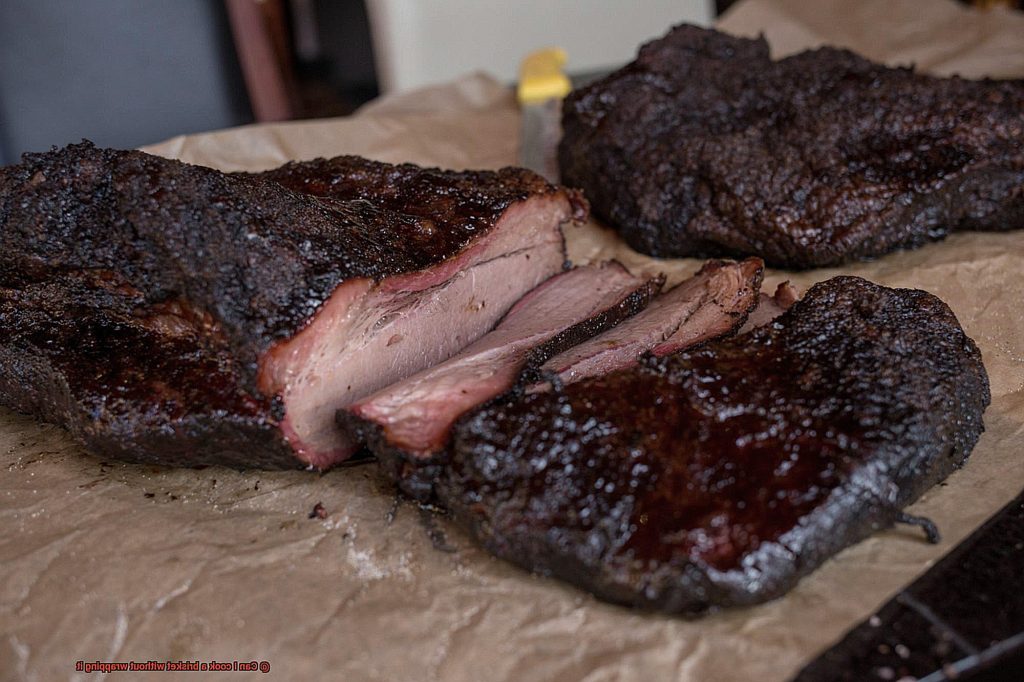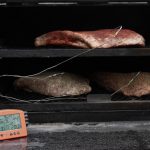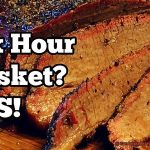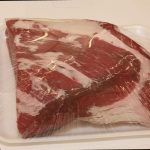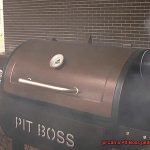Are you a BBQ enthusiast looking to perfect your brisket game? One popular method for cooking brisket is low and slow, but the debate rages on whether wrapping it in foil or butcher paper is necessary. So, can you cook a brisket without wrapping it?
Some pitmasters swear by the wrapping method, while others prefer to smoke their brisket without it for a more authentic taste. But cooking a brisket without wrapping can be challenging, yet yield juicier and deeper flavors.
In this post, we’ll explore why some cooks choose to go without wrapping, the benefits and drawbacks of this method, and how to achieve the perfect result without foil or paper. Whether you’re an experienced pitmaster or novice cook, get ready to dive into the world of cooking a perfect brisket without wrapping.
Contents
What is Brisket?
If you are a meat lover, then you know that there is nothing quite like a tender and juicy beef cut. And when it comes to beef, brisket is one of the best. This cut comes from the lower chest of the animal and is known for its rich flavor and melt-in-your-mouth texture. But what exactly is brisket, and how can you prepare it to perfection?
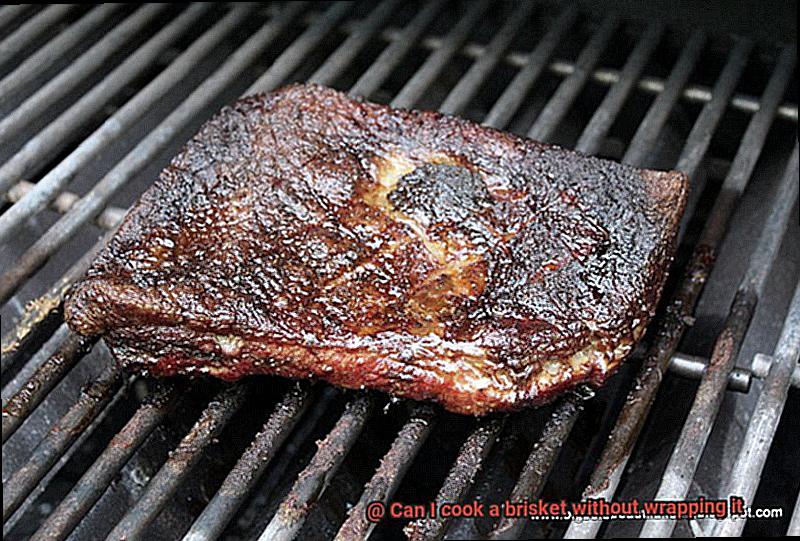
Types of Brisket
Before we dive into cooking methods, let’s discuss the two main types of brisket: the flat and the point. The flat is leaner and more uniform in shape, while the point has more marbling and is thicker at one end. Many pitmasters prefer to cook a whole brisket, which includes both the flat and the point. This allows for a variety of textures and flavors throughout the meat.
Cooking Methods
Brisket is a popular cut for smoking and barbecuing, particularly in Texas-style barbecue. The key to cooking brisket successfully is low and slow cooking. The tough, muscular cut requires long hours of heat to break down the connective tissue and become tender. During this process, the meat is seasoned with a dry rub or marinade and smoked over wood or charcoal for several hours until it reaches an internal temperature of 195-205 degrees Fahrenheit.
To wrap or not to wrap?
One point of contention among pitmasters is whether or not to wrap the brisket during cooking. Wrapping the meat in foil or butcher paper can help retain moisture and speed up cooking time. However, some pitmasters prefer to cook their brisket “naked” or “unwrapped” in order to achieve a crunchy bark on the outside of the meat.
Cooking “naked” can result in a delicious bark on the surface of the meat. The bark is a flavorful crust made up of seasonings, smoke, and rendered fat. It adds a delicious layer of texture and flavor to the finished product. However, cooking a brisket without any wrapping can be a bit trickier than using the wrapped method.
The Debate: Wrapped vs. Unwrapped Brisket
The debate between wrapped and unwrapped brisket has been raging on for years among BBQ aficionados. It’s a topic that can elicit strong emotions and opinions, and for good reason. Brisket is the king of meats, and getting it just right is an art form.
There are those who swear by wrapping their brisket in foil or butcher paper. They argue that wrapping helps retain moisture, speeds up the cooking process, and results in a more tender piece of meat. The Texas Crutch method is a popular technique that involves wrapping the brisket at a specific point during cooking to tenderize it and prevent it from drying out. Wrapping is particularly useful for those with time constraints since it can cut down on cook time by several hours. However, some argue that the resulting texture can be too soft, and that wrapping can interfere with the development of a good bark.
On the other hand, those who prefer to cook their brisket unwrapped believe that it allows for a better smoke flavor and a more distinct bark. Without being wrapped, the meat absorbs more smoke throughout the cooking process, which results in a deeper, smokier flavor. Additionally, leaving the brisket unwrapped allows for better air circulation around the meat, which can help create a more defined and crispy bark.
When it comes down to it, there are several factors to consider when deciding whether to wrap or not to wrap your brisket. First and foremost is personal preference. Experimenting with both methods is key to finding what works best for you and your taste buds. Other factors include your desired texture, cook time, and level of smoke flavor.
Texture is a crucial element to consider when deciding whether or not to wrap your brisket. Those who prefer a softer, fall-apart texture tend to lean towards wrapping their brisket, as it helps break down the connective tissue in the meat resulting in a tender piece of meat. However, those who prefer a firmer texture and a more defined bark tend to opt for cooking their brisket unwrapped.
Cook time is another factor to consider when deciding whether or not to wrap your brisket. Since wrapping creates a mini-oven around the meat, it can speed up the cooking process and result in a more evenly cooked piece of meat. This can be beneficial for those with time constraints.
Benefits of Cooking a Brisket Without Wrapping It
Then, you might want to consider cooking your brisket without wrapping it. As an expert in this area, I can tell you that there are several benefits to taking this approach.
One of the main advantages of not wrapping a brisket is that it allows for more smoke to penetrate the meat. This creates a smokier and more robust flavor that is sure to impress your taste buds. Wrapping the brisket in foil or butcher paper can limit the amount of smoke that can reach the meat, which may not be desirable for some. So if you’re looking for a flavor that really packs a punch, then ditching the wrap might be the way to go.
Another benefit of cooking a brisket without wrapping it is achieving a crispy bark on the outside of the meat. When a brisket is wrapped, steam is created that can soften the bark and make it less crispy. By not wrapping the brisket, the bark has an opportunity to form and develop a desirable texture. Imagine sinking your teeth into a perfectly cooked brisket with a satisfying crunch on every bite.
But that’s not all. Cooking a brisket without wrapping it can also result in a juicier end product. When wrapped, the brisket can become overly moist due to the steam created inside the foil or paper. Cooking without wrapping allows the moisture to evaporate, resulting in a more concentrated and flavorful meat. For those who value maximum flavor and juiciness, cooking your brisket without wrapping it might be just what you need.
Of course, this technique requires more attention and monitoring during the cooking process to ensure that the meat does not dry out. But with practice and patience, you can achieve incredible results that will have everyone coming back for seconds.
To summarize, here are some benefits of cooking a brisket without wrapping it:
- More smoke penetration for a smokier and more robust flavor
- Crispy bark on the outside of the meat
- Juicier end product with concentrated flavors
- Unique and desirable flavor profile
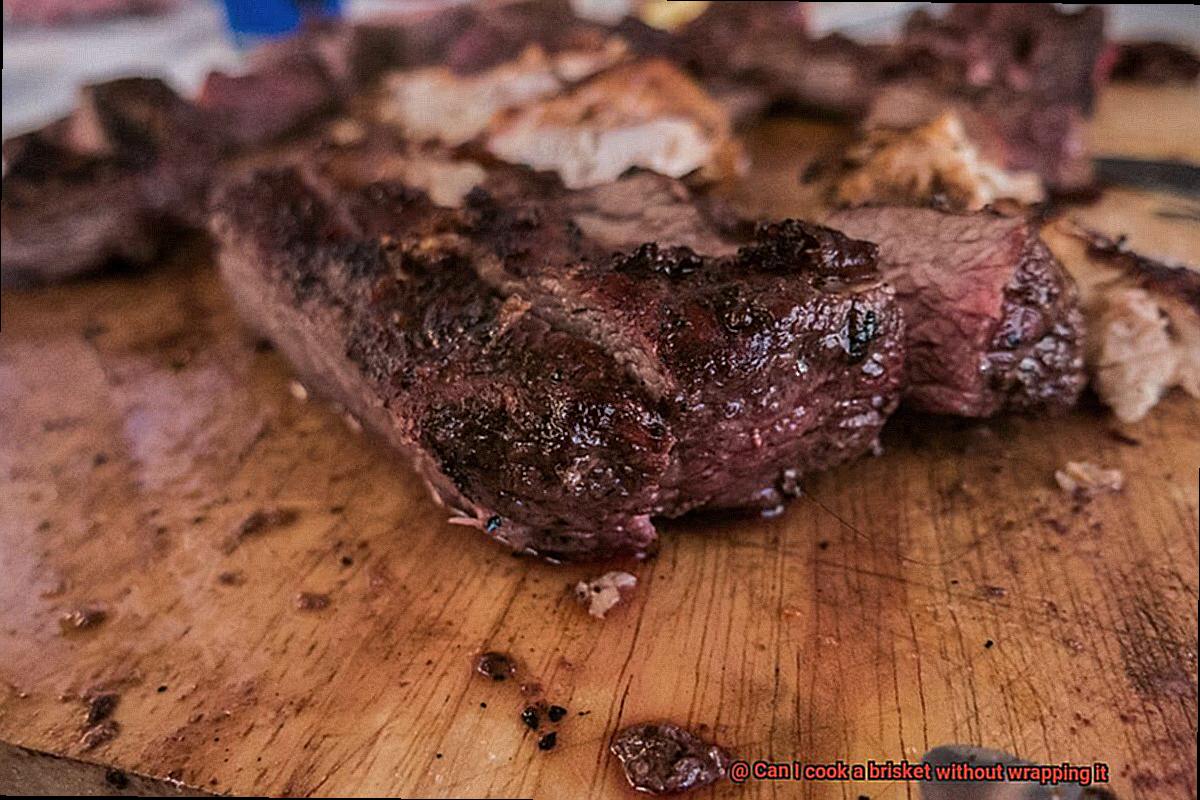
How to Cook a Brisket Without Wrapping It
It requires patience and attention to detail as the meat can dry out if not cooked properly. Here are some tips on how to cook a brisket without wrapping it.
Choosing the right cut of brisket is essential to achieving a juicy and flavorful result. Look for a brisket with good marbling and fat content as this will help keep the meat moist during cooking. Once you have your brisket, trim any excess fat and season it with your preferred rub or marinade.
Once seasoned, preheat your smoker or grill to around 225-250°F and place the brisket on the grill grates, fat side up. Make sure to monitor the temperature of both the meat and the grill to ensure that the brisket cooks evenly. Use wood chunks or chips to provide a smoky flavor to the meat.
As the brisket cooks, it will develop a dark crust known as bark. This is a sign that the meat is absorbing smoke and developing flavor, so resist the urge to wrap it at this stage. Wrapping can cause moisture to build up inside the foil or butcher paper, leading to steaming instead of smoking.
To ensure that the brisket stays moist, spritz it with apple juice or vinegar every hour or so. This will help keep the meat from drying out while also adding extra flavor. Avoid basting or spraying the meat with liquids as this can wash away the rub and delay the formation of bark.
Cooking a brisket without wrapping it can take up to 12-16 hours, depending on the size of the cut. Once cooked, remove it from the heat and let it rest for at least 30 minutes before slicing against the grain. This will allow juices to redistribute throughout the meat and prevent them from running out when you cut into it.
Tips for Cooking a Brisket Without Wrapping It
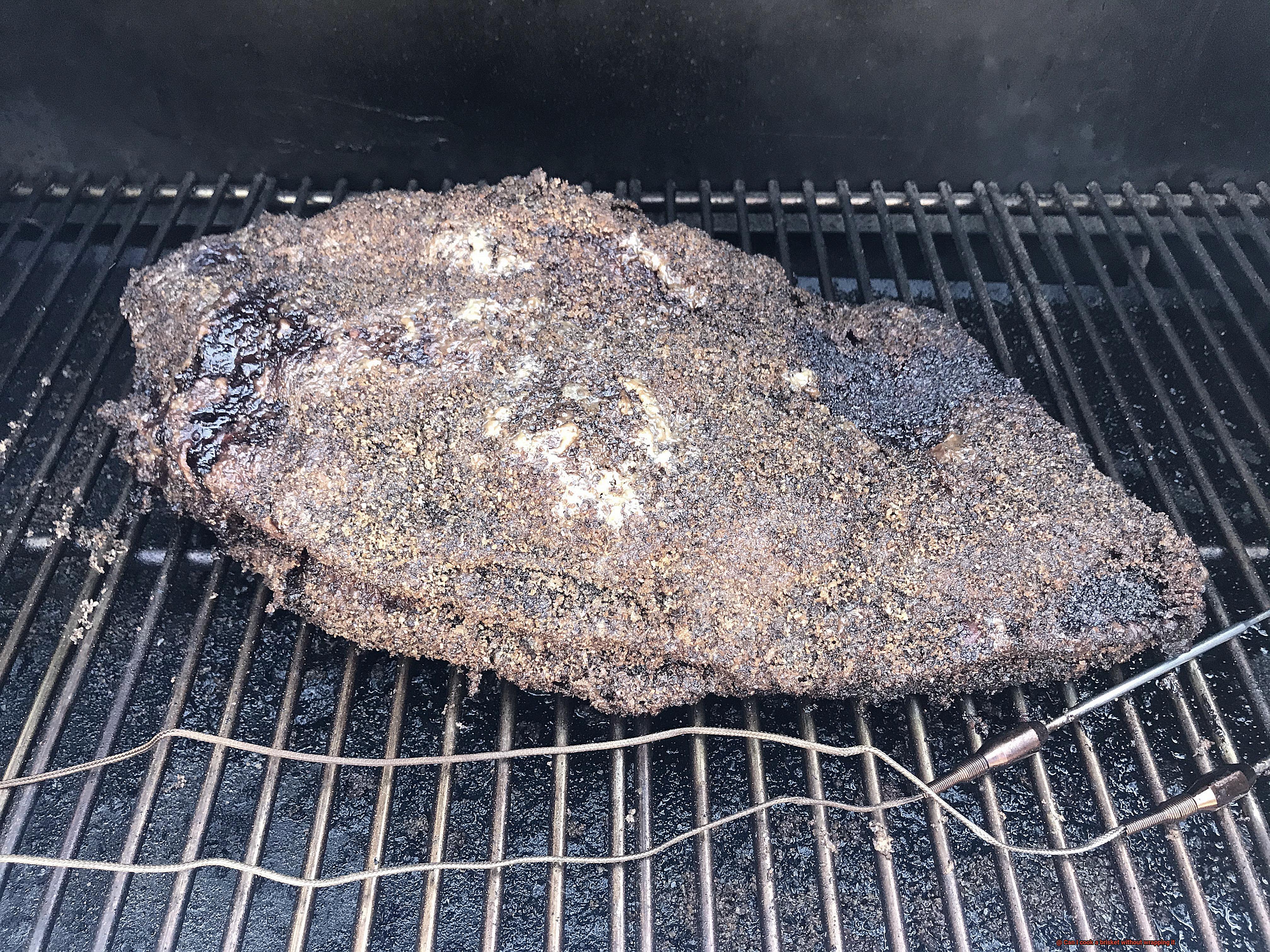
Cooking a brisket without wrapping it requires patience and attention to detail, but the end result is a delicious and flavorful dish that will have everyone asking for seconds. Here are some tips to help you cook a mouthwatering brisket without wrapping it.
Select the Right Cut of Meat:
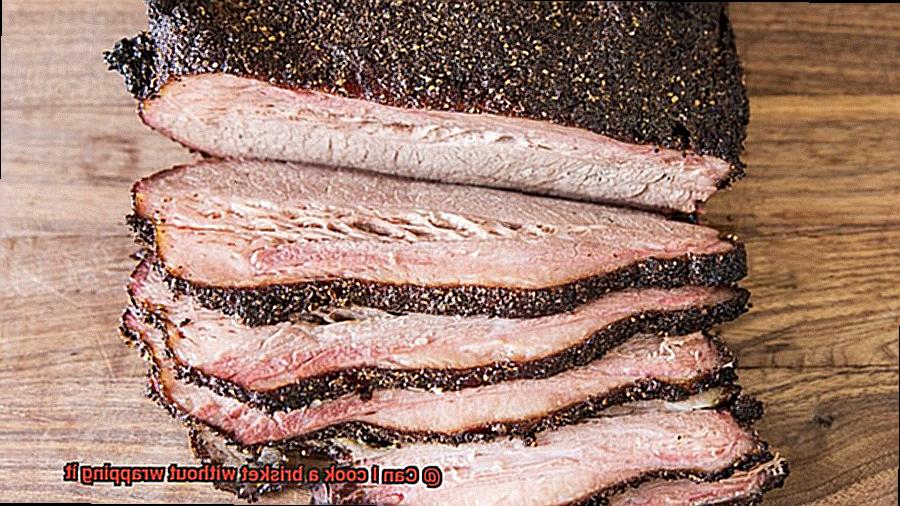
Choosing the right cut of meat is crucial for cooking a brisket without wrapping it. Look for a brisket with good fat marbling and an even thickness throughout. This will help the meat cook more evenly and stay moist during the cooking process.
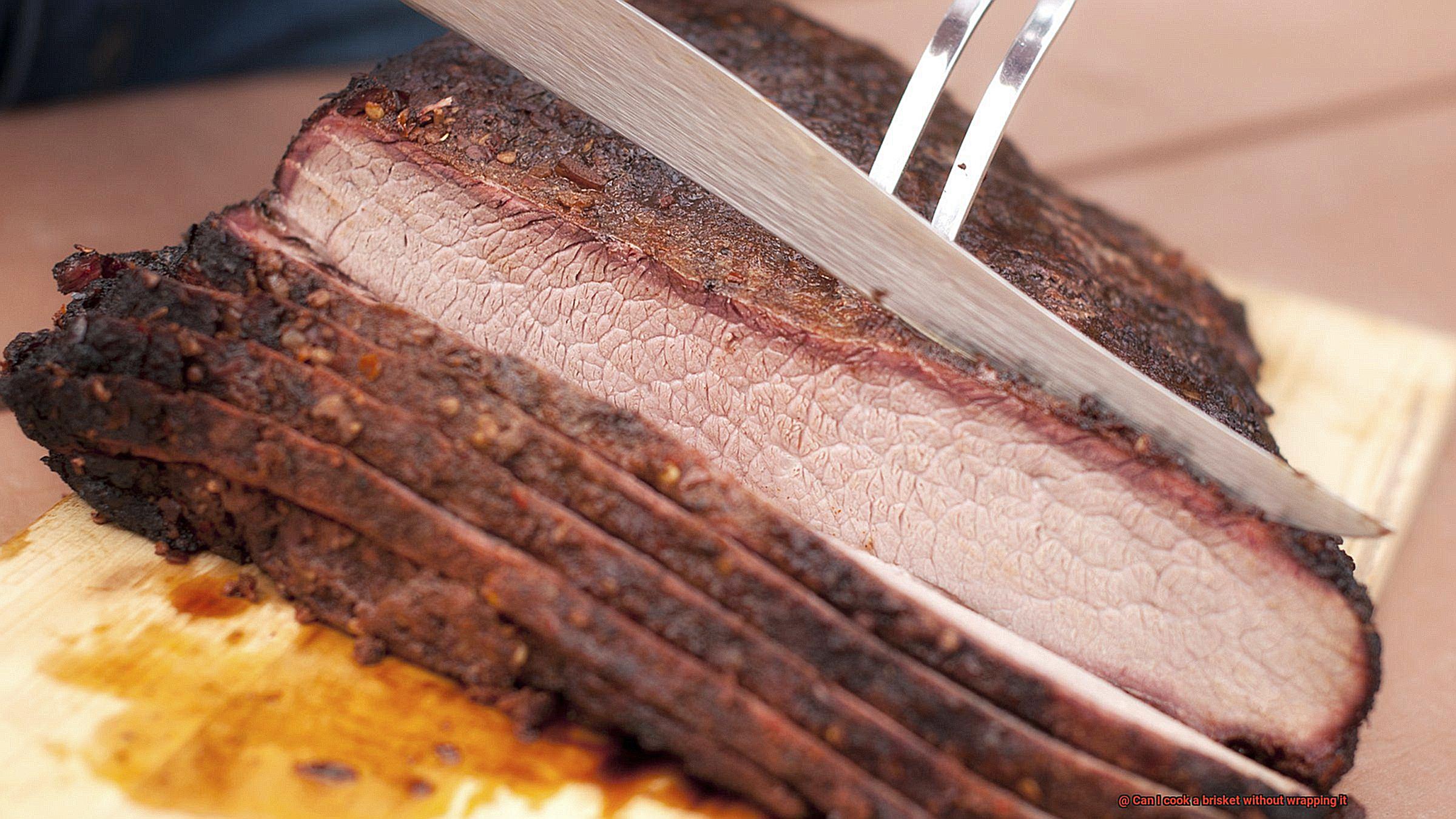
Properly Prepare the Meat:
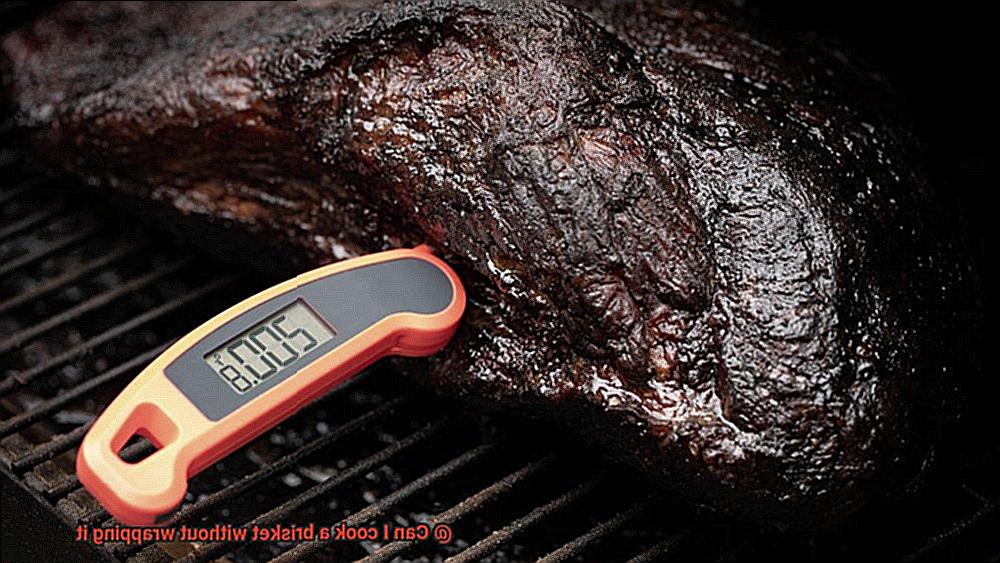
Before cooking, prepare the meat properly by dry brining it with a mixture of salt and other seasonings. Rub the mixture generously all over the brisket and let it sit in the refrigerator overnight. This will enhance the flavor and texture of the meat.
Use a Low and Slow Cooking Method:
To cook your brisket, use a low and slow method such as smoking or slow roasting in the oven. Cook the meat at a low temperature (around 225-250 degrees) for a longer period of time (around 10-12 hours). This allows the fat to render and keeps the meat moist.
Baste Your Brisket with a Mop Sauce:
During cooking, baste your brisket with a mop sauce every hour or so. A mop sauce is a thin liquid (usually vinegar or apple juice) that is brushed onto the meat during cooking. This helps to keep the meat moist and adds flavor.
Let Your Brisket Rest Before Slicing:
After cooking, let your brisket rest for at least 30 minutes before slicing. This allows the juices to redistribute throughout the meat and ensures that it is juicy and tender. Don’t rush this step as it can make all the difference in the final result.
Common Pitfalls to Avoid When Cooking Unwrapped Brisket
Before you dive in, it’s important to know how to avoid common pitfalls that could ruin your culinary masterpiece. Fear not, as we have some expert tips to guide you through the process.
Firstly, be prepared to exercise patience. An unwrapped brisket will cook much slower than a wrapped one. Rushing the process will only lead to tough and dry meat. Give your brisket plenty of time to cook through to the center – it’s worth the wait.
Next, don’t skimp on seasoning. Without a wrap, the meat can dry out quickly, so it’s crucial to use plenty of seasonings and marinades. This will keep your brisket moist and flavorful throughout the cooking process.
Trimming your brisket is another important step that should not be overlooked. Leaving excess fat or gristle on the meat can result in chewy and tough results. Take the time to trim your brisket properly before cooking for the best possible outcome.
Finally, keep a close eye on your cooking temperature. Unwrapped brisket is exposed to direct heat, making it easy for it to overcook or dry out if the temperature is too high. Use a meat thermometer to ensure that your brisket is cooked perfectly without being too dry or overcooked.
Alternatives to Traditional Wrapped Briskets
While wrapping your brisket in foil or butcher paper is a popular traditional method, there are alternative methods that can yield equally delicious results.
One alternative is the Texas crutch method. This involves wrapping your brisket in foil or butcher paper for a shorter amount of time than traditional wrapping. The result? A juicy, tender brisket with a nice bark on the outside. However, you may sacrifice some of the moisture that comes with traditional wrapping.
Another option is to cook your brisket uncovered for the entire cook time. This method can result in a crispy exterior and a tender interior, but it requires careful monitoring and basting to prevent the meat from drying out. You’ll also need to be prepared for some smoke and a longer cook time.
For those who like to live dangerously, you could try the “no wrap” method. This involves cooking the brisket uncovered and without any added moisture or protection. While this method can result in deliciously smoky and flavorful meat, it requires long cook times at low temperatures and careful attention to prevent drying out or burning.
When it comes down to it, deciding which method to use depends on your personal preferences and cooking style. Experiment with different methods until you find one that suits you best. And remember, proper seasoning, trimming excess fat, monitoring cooking temperature closely, and patience are key to achieving the perfect brisket.
8NBeeK_uznM” >
Conclusion
In the world of BBQ, there’s an ongoing debate about whether to wrap a brisket or not. Some pitmasters swear by wrapping their brisket in foil or butcher paper, while others prefer to cook it unwrapped for a more authentic taste. If you’re wondering if you can cook a brisket without wrapping it, the answer is yes – and it can yield some seriously delicious results.
Cooking a brisket without wrapping it requires patience and attention to detail, but the benefits are worth it. Not wrapping allows for more smoke to penetrate the meat, resulting in a smokier and more robust flavor. Plus, you’ll get a crispy bark on the outside of the meat and a juicier end product with concentrated flavors.
To achieve mouthwatering results when cooking an unwrapped brisket, there are several important tips to keep in mind. Choosing the right cut of meat and properly preparing it are crucial steps. Using low and slow cooking methods and basting with mop sauce will help keep your meat moist and flavorful throughout the cooking process. And don’t forget to let your brisket rest before slicing – this step is key for ensuring that your meat stays juicy and tender.
If you’re feeling adventurous, there are alternative methods to traditional wrapped briskets that you can try out. The Texas crutch method involves wrapping your brisket in foil or butcher paper partway through the cooking process. Or, you could try cooking your brisket uncovered for the entire cook time for an even deeper smoky flavor.
Ultimately, deciding which method to use depends on personal preferences and cooking style.

